I should remind myself not to listen to the media (even the public broadcaster) when…
Australian labour market – stagnating due to lack of overall spending
Last month’s Australian labour force data showed what a part-time employment nation we were becoming. The latest labour force data released today by the Australian Bureau of Statistics – Labour Force data – for June 2016 show that employment growth has virtually ground to a halt (although there was positive growth in full-time employment). The Australian labour market has stagnated with low to zero employment growth failing to match the underlying population growth, with the result that unemployment has risen over the last six months. The teenage labour market remains in a poor state and requires urgent policy intervention. Overall, with weak private investment now on-going, the Australian labour market is looking very weak and the Federal government should have introduced a rather sizeable fiscal stimulus in its June 2016 fiscal statement. That is what it should do now it has been re-elected. This should have included a large-scale public sector job creation program which would ensure teenagers regained the jobs that have been lost due to the fiscal drag over the last several years. We won’t be holding our breath!
The summary ABS Labour Force (seasonally adjusted) estimates for June 2016 are:
- Employment increased 7,900 (0.07 per cent) with full-time employment rising by 38,400 and part-time employment falling by 30,600.
- Unemployment increased by 9,900 to 734,200.
- The official unemployment rate rose to 5.8 per cent (0.1 points).
- The participation rate increased by less than 0.1 points to 64.9 per cent. This is well below its November 2010 peak (recent) of 65.8 per cent.
- Aggregate monthly hours worked decreased 4.3 million hours (0.3 per cent), with four of the last five months recording negative growth.
- The quarterly ABS broad labour underutilisation estimates (the sum of unemployment and underemployment) for the May quarter were updated this month. Underemployment rose by 10.8 thousand at 8.4 per cent of the labour force. The total labour underutilisation rate (unemployment plus underemployment) rose by 0.1 per cent to 14.2 per cent. There were 1,067.3 thousand persons underemployed and a total of 1,801.5 thousand workers either unemployed or underemployed. The next quarterly release will be in the August 2016 publication.
The ABS said that:
Employment grew by 0.07 per cent in June, consistent with the average growth rate over the last six months …
The latest Labour Force data shows over the past month, trend employment increased by 8,300 persons to 11,933,400 persons. Trend full-time employment increased by 700 persons after falling for the previous four months. Part-time employment increased by 7,600 persons, its weakest monthly growth since August 2014 …
The figures show that hours worked by employed people declined, but not by as much as in previous months. This reflects the small increase in trend employment. We are yet to see an increase in hours worked in 2016 …
Employment growth – nearly non-existent
Total (net) employment in June 2016 is estimated to have increased by 7,900 jobs. Full-time employment rose by 38,400 and part-time employment fell by 30,600.
The return of some growth in full-time employment reverses the negative outlook since January 2016 but it is still too early to say that the deteriorating labour market situation in Australia has been arrested.
This is especially the case, given the drop in total working hours (see below).
The zig-zag pattern that we have observed over the last 36 months or so – where the employment estimates have been switching back and forth regularly between negative employment growth and positive growth with the occasional spikes – continues.
The following graph shows the month by month growth in full-time (blue columns), part-time (grey columns) and total employment (green line) for the 24 months to June 2016 using seasonally adjusted data.
It gives you a good impression of just how flat employment growth has been over the last 2 years.
The following table provides an accounting summary of the labour market performance over the last six months. The monthly data is highly variable so this Table provides a longer view which allows for a better assessment of the trends. WAP is working age population (above 15 year olds).
Full-time employment has fallen by 18.9 thousand jobs (net) while part-time work has risen by 62.4 thousand jobs. Thus, 143.6 per cent of the total employment created (net) over the last 6 months has been part-time.
The conclusion – overall there have only been 43.4 thousand jobs (net) added in Australia over the last six months while the labour force has increased by only 51.2 thousand. Employment growth has thus failed to outstrip the increase in the supply of labour with the result that unemployment has risen by 7.8 thousand.
This is a seriously under performing labour market.
Employment growth has been pitiful given that the labour force growth has been very subdued, and labour force participation has declined markedly (-0.3 percentage points). The participation rate remains at depressed levels.
Both unemployment and hidden unemployment has risen over the last six months as a result of the poor employment growth.
The following graph shows employment indexes for the last 3 recessions and allows us to see how the trajectory of total employment after each peak prior to the three major recessions in recent history: 1982, 1991 and 2009 (the latter to capture the current episode).
The peak is defined as the month of the low-point unemployment rate in the relevant cycle and total employment was indexed at 100 in each case and then indexed to that base for each of the months as the recession unfolded.
I have plotted the 3 episodes for 100 months after the low-point unemployment rate was reached in each cycle – the length of the current cycle.
The initial employment decline was similar for the 1982 and 1991 recessions but the 1991 recovery was delayed by many months and the return to growth much slower than the 1982 recession.
The current episode is distinguished by the lack of a major slump in total employment, which reflects the success of the large fiscal stimulus in 2008 and 2009.
However, the recovery spawned by the stimulus clearly dissipated once the fiscal position was reversed and the economy fell back into producing very subdued employment outcomes.
While the employment growth was stronger in October and November 2015 we now know that the estimates were distorted by the rotational issues in the sample used by the ABS as well as other issues relating to survey reliability over that period.
Moreover, since February 2008, employment has grown by a miserly 12.2 per cent, which is a very slow pace in historical terms for such a long period.
Given the variation in the labour force estimates, it is sometimes useful to examine the Employment-to-Population ratio (%) because the underlying population estimates (denominator) are less cyclical and subject to variation than the labour force estimates. This is an alternative measure of the robustness of activity to the unemployment rate, which is sensitive to those labour force swings.
The following graph shows the Employment-to-Population ratio, since February 2008 (the low-point unemployment rate of the last cycle).
It dived with the onset of the GFC, recovered under the boost provided by the fiscal stimulus packages but then went backwards again as the last Federal government imposed fiscal austerity in a hare-brained attempt at achieving a fiscal surplus.
The ratio began rising in October 2014 which suggested to some that the labour market had bottomed out and would improve slowly as long as there are no major policy contractions or cuts in private capital formation.
However, the peak in November is now gone and the ratio is once again in retreat.
The on-going fiscal deficit is still supporting some growth in the economy as the spending associated with the mining boom disappears. But the deficit is clearly too small given the behaviour of the real aggregates.
The series remained unchanged in June 2016 but remains 1.8 points below the May 2008 peak of 62.9 per cent.
Teenage labour market – mixed but remains in poor shape
The teenage labour market presented a mixed bag in June 2016 with full-time employment falling by 4.1 thousand and part-time employment rising by 0.7 thousand (net) jobs.
Total employment thus fell by 4.1 thousand (net).
The following graph shows the distribution of net employment creation in the last month by full-time/part-time status and age/gender category (15-19 year olds and the rest)
Over the last 12 months, teenagers have gained only 19.3 thousand (net) jobs overall while the rest of the labour force have gained 205.7 thousand net jobs. Remember that the overall result represents a fairly poor annual growth in employment.
However, full-time employment growth for teenagers over the last 12 months has been negative.
The teenage segment of the labour market is being particularly dragged down by the sluggish employment growth, which is hardly surprising given that the least experienced and/or most disadvantaged (those with disabilities etc) are rationed to the back of the queue by the employers.
The following graph shows the change in aggregates over the last 12 months. It is as if the teenagers have not had a stake in the labour market either way (blue bars barely visible).
To further emphasise the plight of our teenagers, the following graph extends the time period from February 2008, which was the month when the unemployment rate was at its low point in the last cycle, to the present month (June 2016). So it includes the period of downturn and then the so-called “recovery” period. Note the change in vertical scale compared to the previous two graphs.
Since February 2008, there have been only 1,292 thousand (net) jobs added to the Australian economy but teenagers have lost a staggering 90.3 thousand over the same period. It is even more stark when you consider that 119 thousand full-time teenager jobs have been lost in net terms.
Even in the traditionally, concentrated teenage segment – part-time employment, teenagers have gained only 28.7 thousand jobs (net) even though 732.4 thousand part-time jobs have been added overall.
Overall, the total employment increase is modest. Further, around 57 per cent of the total (net) jobs added since February 2008 have been part-time, which raises questions about the quality of work that is being generated overall.
To put the teenage employment situation in a scale context the following graph shows the Employment-Population ratios for males, females and total 15-19 year olds since February 2008 (the month which coincided with the low-point unemployment rate of the last cycle).
You can interpret this graph as depicting the loss of employment relative to the underlying population of each cohort. We would expect (at least) that this ratio should be constant if not rising somewhat (depending on school participation rates).
The facts are that the absolute loss of jobs reported above is depicting a disastrous situation for our teenagers. Males, in particular, have lost out severely as a result of the economy being deliberately stifled by austerity policy positions.
In the last month, with the part-time employment situation improving, there has been some reversal in the downward trends in these ratios.
The male ratio has fallen by 10.8 percentage points since February 2008, the female ratio has fallen by 4.3 percentage points and the overall teenage employment-population ratio has fallen by 7.7 percentage points. That is a substantial decline in the employment market for Australian teenagers.
The other staggering statistic relating to the teenage labour market is the decline in the participation rate since the beginning of 2008 when it peaked in January at 61.4 per cent. In June 2016, the participation rate was just 54.1 per cent.
That is an additional 107.8 thousand teenagers who have dropped out of the labour force as a result of the weak conditions since the crisis.
If we added them back into the labour force the teenage unemployment rate would be 27.2 per cent rather than the official estimate for June 2016 of 17.5 per cent. Some may have decided to return to full-time education and abandoned their plans to work. But the data suggests the official unemployment rate is significantly understating the actual situation that teenagers face in the Australian labour market.
Overall, the performance of the teenage labour market remains poor. It doesn’t rate much priority in the policy debate, which is surprising given that this is our future workforce in an ageing population. Future productivity growth will determine whether the ageing population enjoys a higher standard of living than now or goes backwards.
I continue to recommend that the Australian government immediately announce a major public sector job creation program aimed at employing all the unemployed 15-19 year olds, who are not in full-time education or a credible apprenticeship program.
Unemployment increased by 9,900 to 734,200
The official unemployment rate rose by 0.1 points to 5.8 per cent in June 2016 as a result of employment growth failing to match the growth in the labour force – that is, the underlying population growth given the participation rate was constant.
Overall, the labour market still has significant excess capacity available in most areas and what growth there is is not making any major inroads into the idle pools of labour.
The following graph shows the national unemployment rate from February 1978 to June 2016. The longer time-series helps frame some perspective to what is happening at present.
After falling steadily as the fiscal stimulus pushed growth along, the unemployment rate slowly trended up for some months.
It is now above the peak that was reached just before the introduction of the fiscal stimulus. In other words, the gains that emerged in the recovery as a result of the fiscal stimulus in 2009-10 have now been lost.
Given the weak employment growth, the unemployment rate would be much higher if the labour force was growing as previous trend rates.
Broad labour underutilisation – upwards of 14.2 per cent
The ABS published its quarterly broad labour underutilisation measures for the May-quarter in last month’s data release. So the following is based on the May-quarter underemployment estimates and the June monthly unemployment estimates.
In the May-quarter, total underemployment was 8.4 per cent (1,067.3 persons – up by 10.3 thousand since February) and the ABS broad labour underutilisation rate (the sum of unemployment and underemployment) was 14.2 per cent (up by 0.1 percentage points).
That will have risen marginally as a result of the rise in official unemployment in June 2016 by 7,900.
There were 1,067.3 thousand persons underemployed and a total of 1,801.5 thousand workers either unemployed or underemployed.
The following graph plots the history of underemployment in Australia since February 1978 to the February-quarter 2015.
If hidden unemployment (given the depressed participation rate) is added to the broad ABS figure the best-case (conservative) scenario would see a underutilisation rate well above 16 per cent at present. Please read my blog – Australian labour underutilisation rate is at least 13.4 per cent – for more discussion on this point.
The next update will be for the August-quarter 2016 and will be published published in the September 2016 Labour Force release.
Aggregate participation rate – rose by less than 0.1 points to 64.9 per cent and remains at depressed levels
The June 2016 participation rate remained steady at 64.8 per cent. It remains substantially down on the most recent peak in November 2010 of 65.8 per cent when the labour market was still recovering courtesy of the fiscal stimulus.
What would the unemployment rate be if the participation rate was at the last November 2010 peak level value?
The following graph tells us what would have happened if the participation rate had been constant over the period November 2010 to June 2016. The blue line is the official unemployment rate since its most recent low-point of 4 per cent in February 2008.
The red line starts at November 2010 (the peak participation month). It is computed by adding the workers that left the labour force as employment growth faltered (and the participation rate fell) back into the labour force and assuming they would have been unemployed. At present, this cohort is likely to comprise a component of the hidden unemployed (or discouraged workers).
In recent months the gap between the lines has diverged which signals a deteriorating situation.
Total official unemployment in June 2016 was estimated to be 734.2 thousand. However, if participation had not have fallen relative to November 2010, there would be 916.4 thousand workers unemployed given growth in population and employment since November 2010.
The unemployment rate would now be 7.1 per cent if the participation had not fallen below its November 2010 peak of 65.8 per cent. The official unemployment in June 2016 was 5.8 per cent.
The difference between the two numbers mostly reflects, the change in hidden unemployment (discouraged workers) since November 2010. These workers would take a job immediately if offered one but have given up looking because there are not enough jobs and as a consequence the ABS classifies them as being Not in the Labour Force.
There has been some change in the age composition of the labour force (older workers with low participation rates becoming a higher proportion) but this only accounts for less than 1/3 of the shift. The rest is undoubtedly accounted for by the rise in hidden unemployment.
Note, the gap between the blue and red lines doesn’t sum to total hidden unemployment unless November 2010 was a full employment peak, which it clearly was not. The interpretation of the gap is that it shows the extra hidden unemployed since that time.
This gap shrinks as participation rises relative to the November 2010 peak.
Hours worked – fell by 0.3 per cent in June 2016
Aggregate monthly hours fell by 4.3 million hours (0.26 per cent) in June 2016 in seasonally adjusted terms and have recorded negative growth in four of the last five months.
The following graph shows the monthly growth (in per cent) over the last 24 months. The dark linear line is a simple regression trend of the monthly change – which depicts a declining trend
You can see the pattern of the change in working hours is also portrayed in the employment graph – zig-zagging across the zero growth line.
Conclusion
I repeat my monthly warning – we always have to be careful interpreting month to month movements given the way the Labour Force Survey is constructed and implemented.
Today’s figures show that while employment growth was barely positive this month the pattern of growth continues to zig-zag across the zero growth line.
The full-time employment situation has clearly stagnated since the beginning of this year although there was some growth in that cohort in June 2016.
The conclusion remains that the overall demand side of the labour market is very weak.
Unemployment rose slightly this month but this is largely because the weak employment growth is interacting with weak labour force growth. If labour force growth was consistent with past trends, then the jobs shortfall would be much larger.
The teenage labour market remains in a poor state even though the 15-19 year olds enjoyed part-time employment growth.
I consider this situation to warrant immediate attention by the Federal Government. The neglect of our teenagers will have a very long memory indeed and the negative consequences will be stronger given the ageing population.
The Federal government appears incapable of addressing this dire issue.
The recent re-election of the Conservative government in Australia will further reinforce the negative outlook. They will bang on about training and incentives when they should be announcing job creation programs and infrastructure stimulus spending.
That is enough for today!
(c) Copyright 2016 William Mitchell. All Rights Reserved.
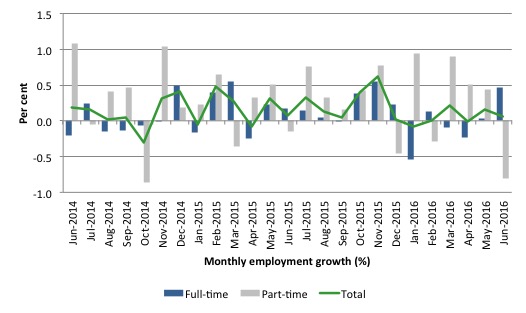
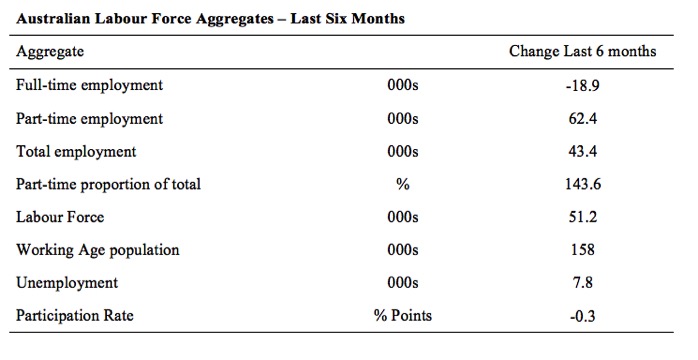
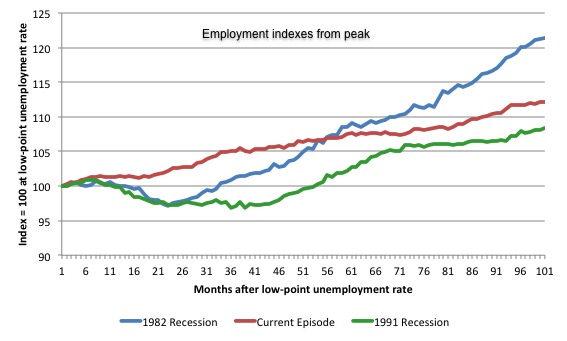
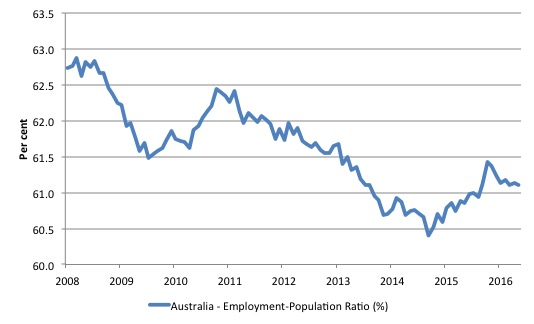
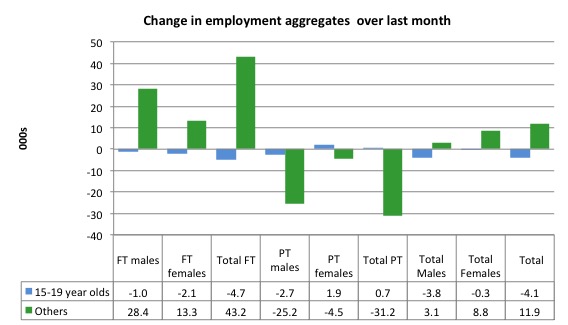
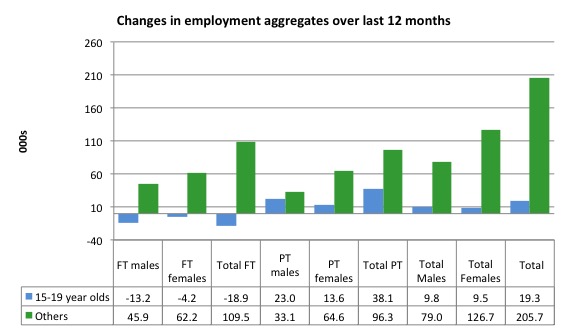
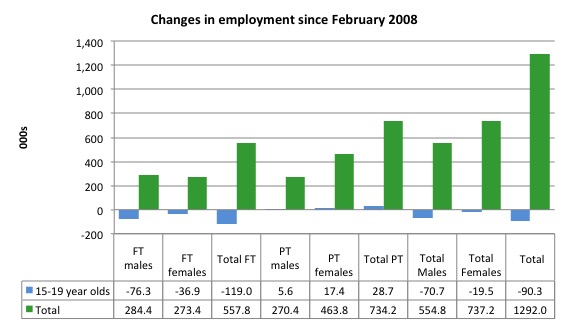
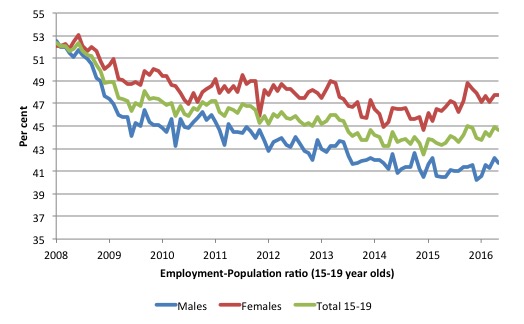
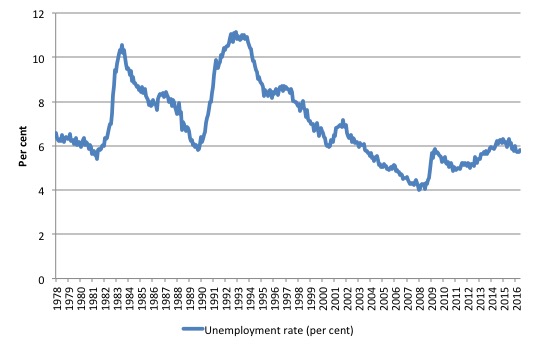

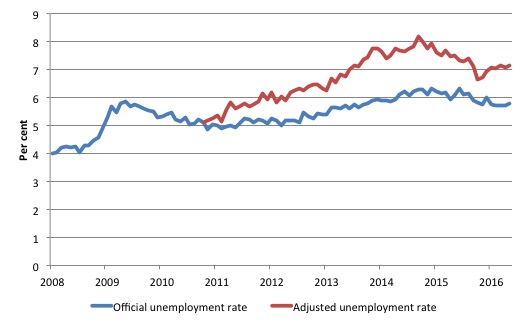
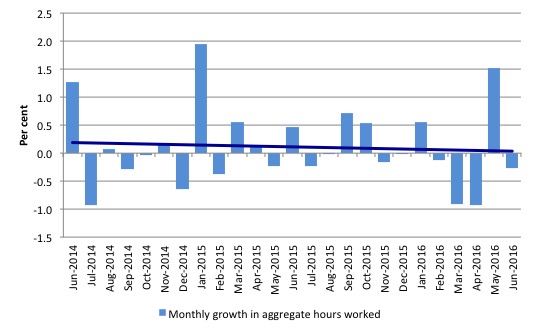
The conservatives seems to believe that interest rates, micro-economic reform, tax cuts (for companies mainly), depreciation write-offs will stimulate “jobs and growth”. No need for fiscal stimulus, that would be too interventionary!
Bill, to what level would Government Spending need to rise to give full employment?
At what point would you start worrying about inflation?
Given most Australians obsession with government surplus and mortgage debt, they almost need the wake up call that comes with recession. Some can hammer home MMT, but it will fall on deaf ears while the public think everything is going well.
I haven’t read all of today’s blog as I have more pressing matters to attend to, but think I have the gist.
Here in the UK there is just a chance we are going to see a sea change in this area. With Geroge Osborne sent to a corner wearing a pointy hat it does look like the new Chancellor, Philip Hammond, is steeling McDonnell’s clothes. Already a hundred billion pound infrstructure spending stimulus has been announced. Sadly, it is being “funded” by borrowing, but we are still members of the EU so subject to the Lisbon Treaty. At least with bond yeilds at historic lows (despite as Bill says the efforts of the Rating Agencies), that isn’t going to cost much and, anyway, that at least can be “funded” from money-creation.
If it comes to pass it will be a vindication of MMT. Here’s hoping…..
Jengis, i believe that Bill Mitchell has estimated that increasing Australia’s fiscal deficit from its present 3.0% of GDP to about 4.5% of GDP, with the increased discretionary spending dedicated to job creation (including a Job Guarantee), capacity building the workforce, improving public services, and improving public infrastructure would be what is required to achieve full employment with stable prices at this point in time.
I hold no hope for Australia, when all we hear from the pollies is “budget repair”.